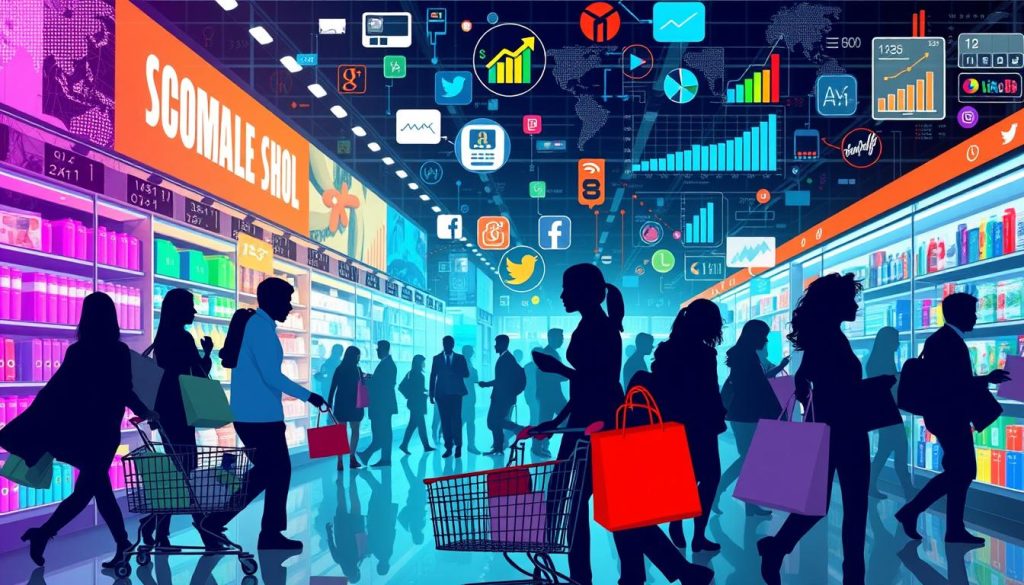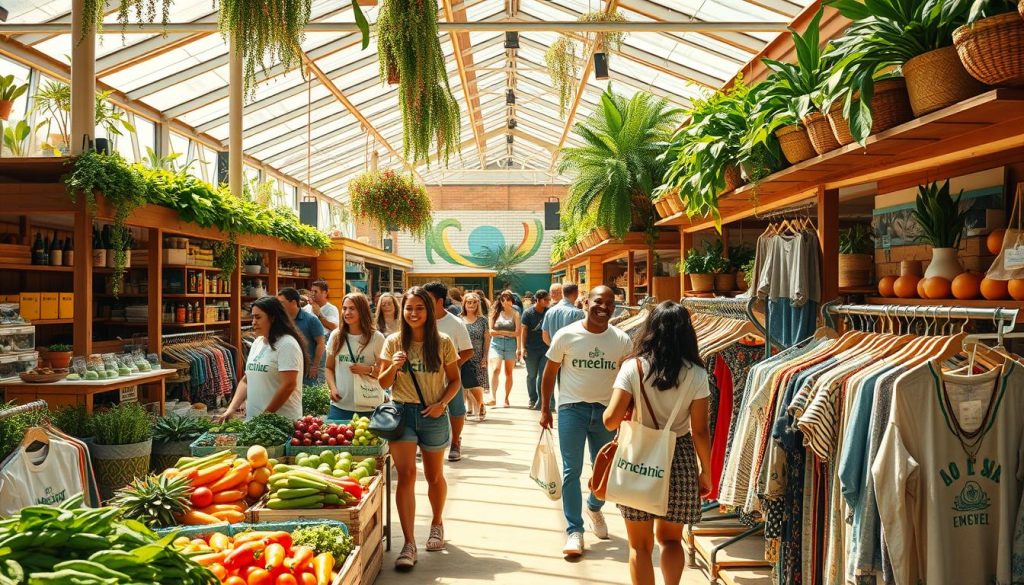I’m excited to explore the ever-changing world of retail trends and consumer behavior. In this article, I’ll take you on a journey through the latest shopping and consumer habits. These changes are reshaping the American retail landscape.
From the rise of online shopping to the return of in-store experiences, we’re seeing a fascinating shift. I’ll dive into the factors driving these changes. We’ll see what they mean for both shoppers and retailers.
Get ready to discover how technology, sustainability, and personalization are transforming the way we shop. Let’s uncover the trends that are defining the future of retail in the United States.
The Evolution of Retail: From Brick-and-Mortar to Digital Dominance
I’ve seen a big change in retail trends over the years. Stores that used to be the main focus are now sharing space with online platforms. This change has changed how we shop and how we analyze markets.
Before, people shopped in stores. Now, online shopping is where it’s at. It offers convenience, a wide range of choices, and personal touches that many love.
Let’s explore how retail has changed:
- 1950s-1990s: Rise of shopping malls and big-box stores
- 2000s: Emergence of e-commerce giants
- 2010s: Mobile shopping becomes mainstream
- 2020s: Omnichannel retail experiences gain popularity
Because of this shift, retailers have had to change their ways. They now aim to offer smooth experiences in both the physical and digital worlds. Market analysis shows that the best brands blend their online and offline presence well.
| Year | Key Retail Trend | Impact on Buying Patterns |
|---|---|---|
| 2000 | E-commerce emergence | 24/7 shopping availability |
| 2010 | Mobile shopping | On-the-go purchases |
| 2020 | Omnichannel retail | Seamless online-offline integration |
Looking ahead, I predict even more exciting retail trends. We’ll see augmented reality shopping and voice commerce, just to name a few. The future of retail will keep mixing the physical and digital, opening up new chances for everyone.
Understanding Modern Consumer Behavior

Consumer behavior has become very complex in today’s digital world. As a marketer, I’ve seen how many things affect what people buy. Let’s explore what shapes today’s shopping habits.
Factors Influencing Purchasing Decisions
Many things influence what we buy. Price, quality, and brand reputation are still important. But now, things like sustainability, ethical practices, and personal experiences also matter a lot.
The Role of Social Media in Shaping Consumer Preferences
Social media has changed how we find and think about products. Influencer advice, what others say, and reviews from friends can really influence our choices. Brands that use these platforms well can greatly shape what we want to buy.
Generational Differences in Shopping Habits
Each age group has its own way of shopping. Baby Boomers like going to stores, while Millennials and Gen Z prefer online. Younger people want things to be easy, fast, and work well on their phones. Knowing these differences helps businesses tailor their marketing to each age.
| Generation | Preferred Shopping Channel | Key Value |
|---|---|---|
| Baby Boomers | In-store | Personal service |
| Gen X | Mix of online and in-store | Practicality |
| Millennials | Primarily online | Convenience |
| Gen Z | Mobile-first | Speed and innovation |
By using these insights, businesses can make their marketing more focused and effective. The secret is to keep analyzing customer data and stay up-to-date with digital trends.
The Rise of E-commerce and Its Impact on Traditional Retail
E-commerce has changed the retail world, making online shopping more popular. Traditional stores are now trying to keep up. Online stores offer convenience and variety that physical shops can’t match.
Retail trends are moving online. Many people like to shop from home, comparing prices easily. This has made it hard for physical stores to stay competitive.
The key to success is the omnichannel experience. Stores are combining online and offline shopping. They offer services like click-and-collect, where you order online and pick up in-store.
Let’s see how e-commerce has affected different retail areas:
| Retail Sector | E-commerce Impact | Adaptation Strategy |
|---|---|---|
| Apparel | High competition from online-only brands | Virtual try-ons, free returns |
| Electronics | Price transparency, showrooming | Price matching, expert advice |
| Groceries | Growth in delivery services | Curbside pickup, subscription boxes |
| Furniture | Visualization challenges | AR apps, 3D room planners |
As e-commerce grows, traditional stores must go digital to stay in the game. They need to understand what customers want and use technology to meet those needs. This way, they can offer experiences that connect online and offline shopping.
Personalization: The Key to Customer Loyalty

In today’s market, personalization is key for loyalty. Businesses use customer insights to create experiences that match what each person likes.
Data-Driven Marketing Strategies
Data-driven marketing changes how we engage with customers. By looking at what they buy, browse, and who they are, companies learn a lot. This helps them understand what customers want.
With this knowledge, businesses can make ads that really talk to each customer. This not only boosts sales but also builds a strong bond between the brand and its fans.
Tailoring Products and Services
Personalization isn’t just for ads. It’s also about making products and services that fit what each customer needs. By knowing what each person likes, companies can suggest things that match their style or past choices.
This makes shopping feel special and personal. It’s this feeling of being understood that often leads to loyalty.
Building Long-Term Relationships
The main goal of personalization is to create lasting bonds with customers. By always offering relevant stuff, brands build trust and become familiar to their audience.
| Personalization Strategy | Impact on Brand Loyalty |
|---|---|
| Personalized Product Recommendations | 30% increase in customer retention |
| Tailored Email Campaigns | 25% higher open rates |
| Customized Loyalty Programs | 40% boost in repeat purchases |
These tactics not only sell more but also make customers happier. Happy customers give more data, which means even better personalization. This cycle is the heart of lasting loyalty in today’s world.
Sustainable Shopping: A Growing Trend

Sustainable shopping is changing how we shop and what we buy. More people are looking for eco-friendly products. This is making retailers change their ways and what they sell.
Ethical brands are becoming more popular. They use sustainable materials and support fair trade. This is making the retail world adapt to new needs.
Let’s look at some key statistics:
| Year | Consumers Prioritizing Sustainability | Retailers Offering Eco-Friendly Products |
|---|---|---|
| 2018 | 35% | 42% |
| 2020 | 45% | 58% |
| 2022 | 62% | 73% |
These numbers show a clear increase in both consumer and retailer actions. Retailers are now using transparent supply chains and recyclable packaging. They are also making their stores more energy-efficient.
This change is not just about products. Sustainable shopping is changing how we buy, where we shop, and how products are delivered. This trend will keep shaping the retail industry for years to come.
The Influence of Technology on Shopping Experiences
Technology has changed how we shop. I’ve seen how digital tools mix the physical and virtual worlds. This creates a new way of shopping.
Augmented Reality in Retail
Augmented Reality (AR) is changing how we see products. Now, you can try on clothes and makeup virtually. This lets you see items in your space before buying.
This tech helps avoid returns and makes buying more confident.
Voice Commerce and Smart Home Devices
Voice-activated assistants like Alexa and Google Home make shopping easy. You can order groceries and more just by talking. This hands-free shopping is changing how we buy things.
Mobile Shopping and Payment Solutions
Smartphones are our shopping friends. Mobile apps give us deals and easy checkout. Digital wallets and contactless payments make buying faster and safer.
Data Analytics help improve these tech advances. Stores use data to make shopping better. They tailor experiences and predict trends. This makes shopping more personal and efficient.
The Power of Reviews and User-Generated Content
I’ve seen a big change in how people buy things. Reviews and content from users are now key in understanding customers and building loyalty. When I shop online, I always look at what others say before buying.
Good reviews can really help a sale. They show that others trust the brand. Companies use these reviews on their sites and social media. It’s a smart way to connect with customers.
But, bad feedback can also be useful. It helps companies improve what they offer. I’ve seen brands turn unhappy customers into loyal fans by fixing their problems publicly.
Getting customers to share their experiences is important. Some ways to do this include:
- Offering rewards for reviews
- Starting hashtag campaigns for content from users
- Using customer stories in ads
Reviews and user content help brands understand their customers better. They can change how people buy and keep customers coming back. It’s good for both businesses and shoppers.
Convenience vs. Experience: Balancing Consumer Demands
In today’s fast world, shopping habits are changing fast. People want both convenience and memorable experiences. This change is making retailers rethink their strategies.
The Rise of Same-Day Delivery and Instant Gratification
Same-day delivery is changing retail. Shoppers want things fast, so stores must improve their delivery. This shows our need for quick satisfaction in shopping.
Experiential Retail: Creating Memorable Shopping Moments
Even with online shopping, physical stores are still important. Stores are now focusing on unique experiences. These experiences help build loyalty and offer something online can’t.
Subscription Models and Recurring Purchases
Subscription services are becoming popular. They offer convenience and stable income for businesses. This changes how we view regular purchases and loyalty.
| Shopping Trend | Consumer Benefit | Retailer Challenge |
|---|---|---|
| Same-Day Delivery | Instant Gratification | Logistics Optimization |
| Experiential Retail | Memorable Moments | Store Design Innovation |
| Subscription Models | Convenience | Customer Retention |
Successful retailers need to balance convenience and experience. Understanding these changes is crucial for staying ahead in the market.
Navigating the Omnichannel Landscape
Retail trends have changed a lot in recent years. The omnichannel experience is now key for businesses to meet customer needs. It’s not just about having many channels; it’s about making a smooth journey across all touchpoints.
Data analytics are crucial in this new world. By studying customer behavior, businesses can offer personalized experiences. This helps connect online and offline shopping, creating a unified brand experience.
The secret to success in the omnichannel world is integration. Retailers must make sure their stores, websites, mobile apps, and social media work together well. This way, customers can start shopping on one platform and finish on another without trouble.
Looking ahead, I see more new ideas in the omnichannel area. From augmented reality try-ons to AI-powered customer service, the options are vast. The future of retail will be shaped by how well businesses use and improve their omnichannel strategies.

